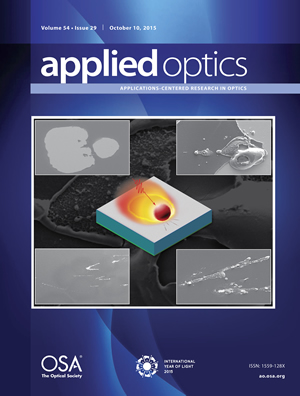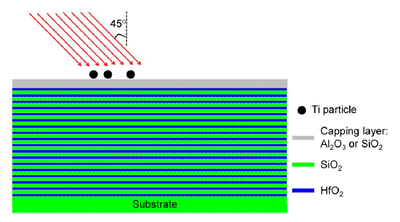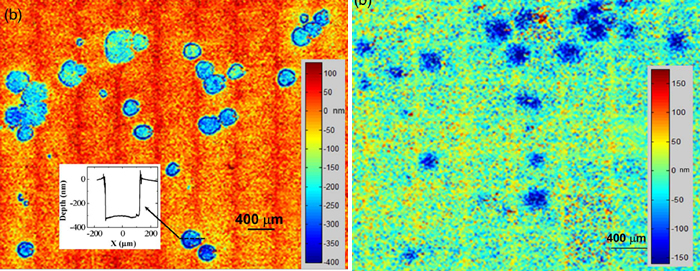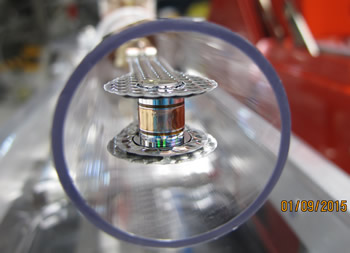Papers and Presentations - 2015
October
Shaped Laser Pulse Experiments Boost Understanding of NIF Performance
Protecting Mirror Coatings Against Laser Damage
The continuing efforts to find ways to protect optical components from damage in high-energy laser systems such as NIF were highlighted in the cover article in the Oct. 10 issue of Applied Optics.

In the paper, Roger Qiu and colleagues from LLNL and the Laboratory for Laser Energetics (LLE) at the University of Rochester reported on the results of a study comparing the ability of silicon dioxide or silica (SiO2) vs. aluminum oxide (Al2O3) protective layers, or “caps,” to limit damage to laser-system mirror coatings when surface contaminants are exposed to high-fluence laser light. The Laboratory Directed Research and Development (LDRD)-funded research was aimed at understanding the underlying mechanism that governs the laser-contaminant-interaction-induced damage of the protective layer of infrared high-reflection (HR) mirror coatings.
Multilayer HR mirror coatings play a key role in NIF and other high-peak-power laser systems by reflecting and redirecting the laser light along the beamlines and onto the target. While high dielectric constant multilayer coatings have been shown to provide significant laser-damage resistance in these systems, their performance and lifetimes are often limited by damage induced through the coupling between the laser and contaminating particles that are inadvertently deposited on the surface during optical processing, handling, installation, and laser operations. Adding a protective capping layer above the original HR mirror coatings has been shown to improve laser-damage resistance, depending on the capping layer’s thickness.
 Schematic of laser-particle interaction damage testing of capping layers on silica-hafnia multilayer coatings in the presence of titanium particles.
Schematic of laser-particle interaction damage testing of capping layers on silica-hafnia multilayer coatings in the presence of titanium particles. The researchers combined experimental testing with optical thermal-mechanical modeling to investigate the response of SiO2 and Al2O3 capping layers when exposed to a single oblique shot of a 1,053-nanometer (infrared) laser beam, with a fluence of about 10 joules per square centimeter and a pulse length of 14 nanoseconds, in the presence of spherical titanium (Ti) particles on the surface of silica-hafnia multilayer coating samples. Silica-hafnia multilayers are commonly used as high reflectors in high-peak-power laser systems that require high laser-damage resistance.
“We found that the damage responses of the two different capping layers to the laser-particle interaction exhibited a great contrast,” the researchers reported. “Under identical laser irradiation conditions, the damage to the Al2O3 capping layer is much more severe than that to the SiO2 layer; at the Ti particle locations, the Al2O3 capping layer is completed delaminated, but the SiO2 layer is only mildly modified. The large difference in damage behavior is mainly attributed to the disparity in the thermal expansion coefficients of the two capping materials, with that of the Al2O3 layer being about 15 times greater than that of SiO2.
“Thermal-mechanical calculations combined with optical modeling show that the large difference in thermal expansion coefficients leads to large differences in thermally induced mechanical stress between the capping layer and the adjacent layer below,” they said. “In the Al2O3 case, this is approximately 64 times greater than in the SiO2 case. Thus, SiO2 is shown to be a more effective material for use as a capping material to protect against debris-induced laser ablation and damage on high-power dielectric-coated mirrors.”
 (Left) Confocal microscope image showing the depth map of the damage sites on multilayer coating with the Al2O3 cap layer after one laser shot at about 10 J∕cm2. Inset: horizontal line-out profile of indicated pit. (Right) Confocal microscope image showing the depth map of the modified site on multilayer coating with the SiO2 cap layer.
(Left) Confocal microscope image showing the depth map of the damage sites on multilayer coating with the Al2O3 cap layer after one laser shot at about 10 J∕cm2. Inset: horizontal line-out profile of indicated pit. (Right) Confocal microscope image showing the depth map of the modified site on multilayer coating with the SiO2 cap layer. “The results provide important insights into the underlying mechanisms by which laser-particle interaction leads to damage of the protective capping layer in multilayer coating systems for oblique laser applications,” Qiu added, “and offer a framework for a strategy for rational selection of capping materials that would ultimately extend the lifetime of NIF transport mirrors.”
Joining Qiu were LLNL colleagues Mary Norton, Rajesh Raman, Sasha Rubenchik, Charles Boley, Paul Mirkarimi, Chris Stolz, and Ibo Matthews, and Amy Rigatti of LLE.
Shaped Laser Pulse Experiments Boost Understanding of NIF Performance
In a recent series of papers, LLNL scientists examined the role of ablation-front instability and capsule convergence ratio in ignition science experiments at NIF.
The papers address different aspects of an “adiabat-shaping” experimental campaign which was performed to controllably assess the effects of ablation-front instability growth vs. fuel adiabat (compression) on implosion performance.
The researchers said this work marks an important step forward in the quest for ignition by demonstrating that ablation front instability growth can be managed while simultaneously achieving high area density, a necessary requirement for inertial confinement fusion (ICF) ignition. The target used in a three-shock adiabat-shaping experiment. Furthermore, the results help to confirm ablation-front growth as one of the dominant sources of performance degredation during the National Ignition Campaign (NIC).
The target used in a three-shock adiabat-shaping experiment. Furthermore, the results help to confirm ablation-front growth as one of the dominant sources of performance degredation during the National Ignition Campaign (NIC).
The campaign was designed to understand the physics of layered deuterium-tritium (DT) implosions as related to the four-shock low-foot (LF) approach used during the National Ignition Campaign that featured a lower foot, or initial laser picket, in the laser pulse, and the three-shock high-foot (HF) approach that featured a higher foot in the laser pulse.
The HF was designed to reduce both ablation front instability and capsule convergence ratio that together led to a substantial increase in yield. The question was how much of the improved performance was due to the lower hydrodynamic instability and how much was from the lower convergence ratio. These experiments were designed to help shed light on this question.
Two new drives were designed for this mini-campaign: a four-shock adiabat-shaped drive derived from the LF drive and a three-shock adiabat-shaped drive derived from the HF drive. Adiabat shaping is based on a strong first shock that decays as it propagates through the shell of the target capsule toward the DT fuel. It sets the ablation front on a higher adiabat (beneficial for stabilization of hydrodynamic instabilities), while keeping the adiabat in the DT fuel at a lower adiabat (needed for high compression). The concept of adiabat shaping was previously proposed and developed in direct-drive inertial confinement fusion (ICF) experiments at the OMEGA Laser Facility at the University of Rochester (NIF experiments are primarily indirect drive).
In a Physical Review Letters paper titled, “Improved performance of high areal density indirect drive implosions at the National Ignition Facility using a four-shock adiabat shaped drive,” lead author Dan Casey and colleagues describe a significant improvement in implosion performance using a four-shock adiabat-shaped drive with a small increase in early-time laser pulse energy. This modest laser pulse change (a less than 1 percent change in total energy) leads to reduced ablation front instability growth comparable to the high-foot experiments, while simultaneously allowing for a low fuel adiabat, resulting in high implosion areal density and convergence ratio comparable to the NIC.
“This adiabat-shaped version of the LF showed a three to ten times improvement in yield compared to similar experiments during the National Ignition Campaign,” Casey said, but still lower than the high-foot experiments. “This result helps to separate the deleterious impact of ablation front growth from convergence on implosions during the NIC and supports the hypothesis that seeds at the ablation front—for example, the capsule support tent— played a significant role in limiting (implosion) performance.”
Since the NIC, researchers have learned that the “tent” that supports the capsule inside the hohlraum seeded a large perturbation that was amplified by ablation-front instability and was likely the dominant factor degrading the performance of NIC capsules. Reducing this with the high-foot approach was an important factor in improving performance.
In a Physics of Plasmas paper titled, “Stabilization of high-compression, indirect-drive inertial confinement fusion implosions using a 4-shock adiabat-shaped drive,” lead author Andrew MacPhee and colleagues describe using the recently developed laser pulse profile in separate focused physics experiments to directly confirm the reduction in the ablation-front instability growth, while maintaining conditions for a low fuel adiabat needed for increased compression.
 Experimental setup for the four-shock adiabat-shaped drive experiments showing the simulated capsule trajectory with four x-ray camera gate times. Insets: Cutaway view of the hohlraum with re-entrant cone and vanadium backlighter foil; photo of the capsule with gold cone and machined surface ripples.
Experimental setup for the four-shock adiabat-shaped drive experiments showing the simulated capsule trajectory with four x-ray camera gate times. Insets: Cutaway view of the hohlraum with re-entrant cone and vanadium backlighter foil; photo of the capsule with gold cone and machined surface ripples.
Finally, in another Physics of Plasmas paper, “First results of radiation driven, layered deuterium-tritium implosions with a 3-shock adiabat-shaped drive at the National Ignition Facility,” lead author Vladimir Smalyuk and colleagues discuss using the campaign’s new three-shock adiabat-shaped drive, derived from the HF pulse, to increase the overall capsule convergence ratio and compression.
“The fuel areal density was improved by approximately 25 percent with this new drive compared to similar high-foot implosions,” Smalyuk said, “although in this case neutron yield remained comparable to the high-foot experiments rather than increasing.” A leading hypothesis is that asymmetry in the x-ray drive from the hohlraum currently prevents increases in performance that might otherwise be expected from increased fuel areal density or equivalently, convergence ratio. Improving the hohlraum drive symmetry is now a major focus of the program.
Casey was joined by LLNL co-authors Jose Milovich, Vladimir Smalyuk, Dan Clark, Harry Robey, Arthur Pak, Andrew MacPhee, Kevin Baker, Chris Weber, Tammy Ma, Hye-Sook Park, Tilo Döppner, Deborah Callahan, Steve Haan, Prav Patel, Luc Peterson, Charles Yeamans, John Edwards, Otto Landen, Kai Lafortune, Brian MacGowan, Clay Widmayer, Daniel Sayre, Robert Hatarik, Essex Bond, Sabrina Nagel, Robin Benedetti, Nobuhiko Izumi, Shahab Khan, Benjamin Bachmann, Brian Spears, and Charles Cerjan and colleagues from General Atomics, Los Alamos National Laboratory and the Massachusetts Institute of Technology.
MacPhee was joined by LLNL colleagues Peterson, Casey, Clark, Haan, Landen, Milovich, Robey, Smalyuk, and Oggie Jones.
Smalyuk was joined by LLNL co-authors Robey, Döppner, Jones, Milovich, Bachmann, Baker, Bond, Callahan, Casey, Cerjan, Clark, Haan, Lafortune, Landen, MacGowan, MacPhee, Pak, Patel, Peterson, Weber, Widmayer, Yeamans, Peter Celliers, Sham Dixit, John Edwards, Alex Hamza, Omar Hurricane, Ken Jancaitis, Jeremy Kroll, and Laura Berzak Hopkins, and colleagues from General Atomics and the University of Rochester’s Laboratory for Laser Energetics.



